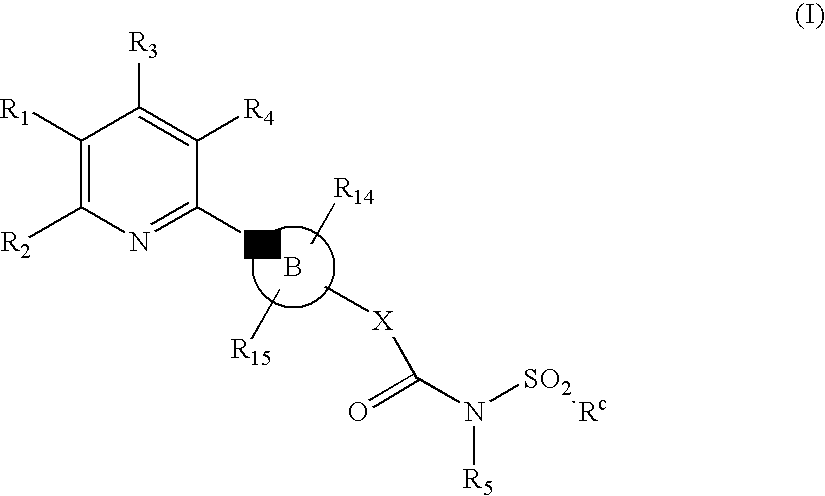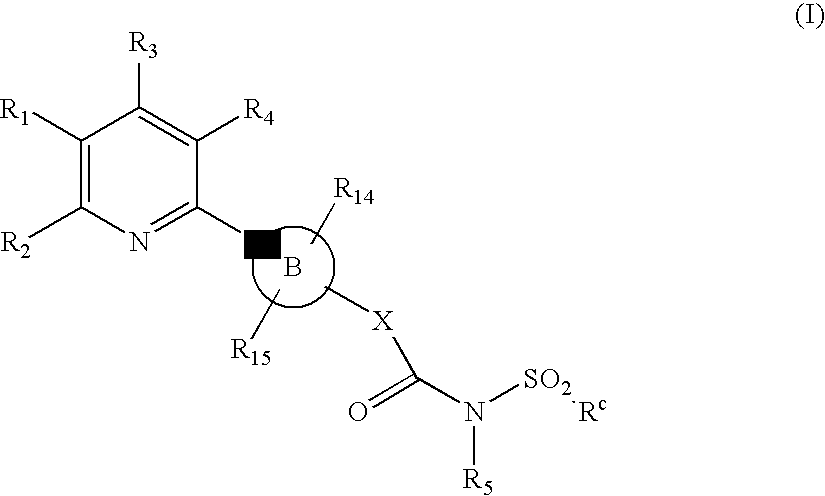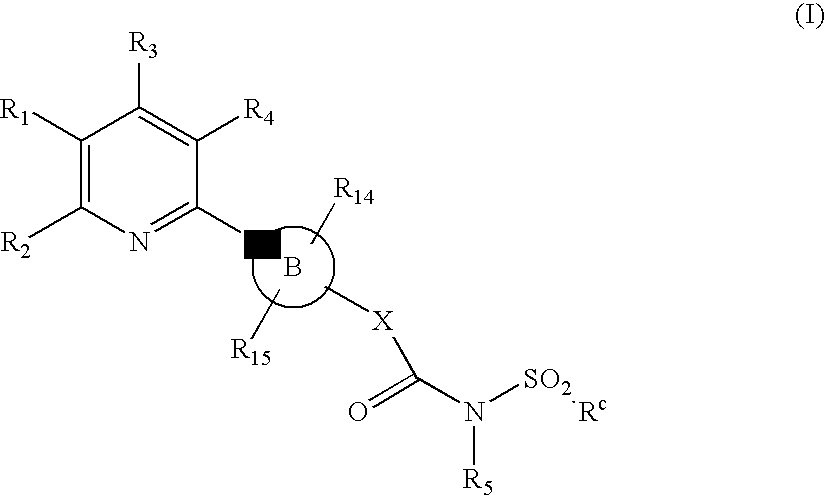Novel Pyridine Compounds
a technology of pyridine and compound, applied in the field of new pyridine compounds, can solve the problems of high morbidity, affecting the success of interventions used to prevent or alleviate these conditions, and compromising the success of interventions such as thrombolysis and angioplasty, and achieves high selectivity and potency. high
- Summary
- Abstract
- Description
- Claims
- Application Information
AI Technical Summary
Benefits of technology
Problems solved by technology
Method used
Image
Examples
example 18 0.52
Example 10 0.61
[0436] Platelet aggregation in washed platelet suspension: Citrated blood was centrifuged for 15 min at 240×g. The supernatant containing the platelet rich plasma (PRP) was transferred to new tubes and PGI2 was added to a final concentration of 0.8 μM. The PRP was centrifuged for 10 min at 125×g in order to pellet and discard the remaining RBC. The platelets in the PRP (supernatant) were centrifuged for 10 min at 640×g and re-suspended in PBS without Ca and Mg, supplemented with 10 mM Hepes, 2.7 mM KCl, 1 mM MgCl2, 0.1% D-glucose, and 0.8 M PGI2 (37° C.). Platelets were pelleted by centrifugation for 15 min at 640×g and re-suspended in PBS without PGI2 to 200×109 / L. Washed platelet suspension was kept at 4° C. for 2 h prior to used in the experiments in order for the inhibitory effect of remaining PGI2 to ablate.
[0437] Compounds were diluted in DMSO and 0.5 μL was added per well in a 96-well plate. 150 μL platelet suspension (with CaCl2 and fibrinogen added to a fi...
example 1
Ethyl 5-chloro-6-[4-({[(2-methylphenyl)sulfonyl]amino}carbonyl)piperazin-1-yl]nicotinate
(a) Ethyl 5-chloro-6-piperazin-1-ylnicotinate
[0468] Ethyl 5,6-dichloronicotinate (2.20 g, 10.0 mol) was weighed into an Erlenmeyer flask. piperazine (1.03 g, 12.0 mol), triethylamine (1.21 g, 12.0 mol), and absolute ethanol (20.0 mL) were added. The mixture was stirred until a clear solution appeared. This solution was divided into 10 microwave vials. Each vial was heated in the microwave reactor, at 120° C. for 10 minutes. The combined reaction mixtures were extracted with ethylacetate (3×80 mL) from a 10% potassium carbonate solution (80 mL). The combined organic extracts were evaporated in vacuo. The crude material was purified by flash chromatography (DCM / MeOH / triethylamine 9:1:0.1) to give Ethyl 5-chloro-6-piperazin-1-ylnicotinate. Yield: 1.60 g (61%).
[0469]1H NMR (400 MHz, CDCl3): 1.38 (3H, t, J=7.2 Hz), 1.77 (1H, br s), 3.01-3.05 (4H, m), 3.51-3.55 (4H, m), 4.36 (2H, t, J=7.2 Hz), 8.12 ...
example 2
Ethyl 5-chloro-6-[4-({[(4-methylphenyl)sulfonyl]amino}carbonyl)piperazin-1-yl]nicotinate
[0474] Ethyl 5-chloro-6-piperazin-1-ylnicotinate (0.108 g, 0.40 mmol) was dissolved in DCM (3.0 mL) and 4-methylbenzenesulfonyl isocyanate (0.095 g, 0.48 mmol) was added at room temperature. The reaction mixture was stirred at room temperature under nitrogen for 14 h and then evaporated. The crude material was purified by preparative HPLC using a gradient (Acetonitrile / ammonium acetate buffer(0.1M) 1948%) followed by removal of solvents by freeze-drying to give Ethyl 5-chloro-6-[4-({[(4-methylphenyl)sulfonyl]amino}carbonyl)piperazin-1-yl]nicotinate. Yield: 0.077 g (41%)
[0475]1H NMR (400 MHz, CDCl3): δ 1.37 (3H, t, J=7.2 Hz), 2.34 (3H, s), 3.36-3.42 (4H, m), 3.50-3.56 (4H, m), 4.35 (2H, q, J=7.2 Hz), 7.16-7.21 (2H, m), 7.84-7.88 (2H, m), 8.07 (1H, d, J=1.9 Hz), 8.68 (1H, d, J=1.9 Hz).
[0476] MSm / z: 467 (M+1).
PUM
 Login to View More
Login to View More Abstract
Description
Claims
Application Information
 Login to View More
Login to View More - R&D
- Intellectual Property
- Life Sciences
- Materials
- Tech Scout
- Unparalleled Data Quality
- Higher Quality Content
- 60% Fewer Hallucinations
Browse by: Latest US Patents, China's latest patents, Technical Efficacy Thesaurus, Application Domain, Technology Topic, Popular Technical Reports.
© 2025 PatSnap. All rights reserved.Legal|Privacy policy|Modern Slavery Act Transparency Statement|Sitemap|About US| Contact US: help@patsnap.com



